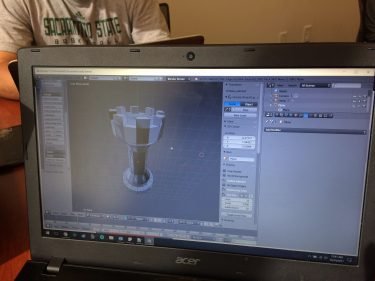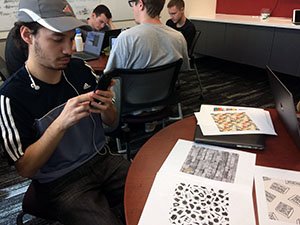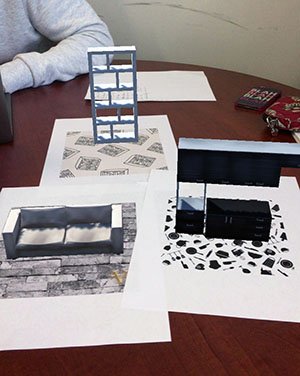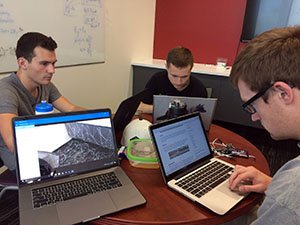
Story and photos by Lana Sweeten-Shults
GCU News Bureau
GCU junior computer science major and S.M.U.R.F. student researcher Shaun Wang looks as if he stepped out of a “Terminator” movie. You almost expect him to declare, “I’ll be back.”
Instead, donning a pair of spacey-cool, dark glasses so huge they cover a third of his face, Wang reaches into the air and motions his right hand into a kind of midair click and then widens the space between his thumb and forefinger, as if he were increasing the size of an image on his smartphone. It’s air guitar, only with midair touchscreen taps and smartphone motions replacing the guitar.
As it turns out, Wang isn’t swatting at imaginary flies.

Through Microsoft’s HoloLens, Wang is seeing something the rest of us can’t, unless we glance at his laptop screen or take a peek through the HoloLens.
That's where you can see what he does: the gray, striped rug of the Honors College conference room in the College of Science, Engineering and Technology. It is covered by thin white lines spanning the screen, almost like a map of constellations with white lines fanning out through space and connecting the stars. The computer, in this case, isn't connecting stars but mapping out the room.
Then you see something that’s not there in the real world but is there on the computer screen – three virtual white balls sitting atop the rug.
The scene is a mix of the real world – the real-life Honors College conference room space – and the digitally created white balls. The real and virtual co-exist in layers of reality and virtual reality via a program called Unity, which creates 3D environments and applications, and the HoloLens, a mixed reality device, or MR device. Also called a hybrid reality gadget, the device merges elements of the real and virtual worlds by superimposing virtual objects in the wearer’s field of vision.
Wang is one of several student researchers on a number of teams working on mixed- and augmented-reality projects this semester as part of S.M.U.R.F., or Smart Urban Fabrics, one of the groups that's part of CSET’s Research and Design Program. About 15 students are part of the group, which meets on Tuesdays and Thursdays.
These student researchers will demonstrate some of their projects during Health Sciences, Engineering and Technology Day on Wednesday. It's when thousands of high school juniors and seniors will visit the campus to see what it has to offer. The S.M.U.R.F. team will be in Room 133 of Building 57. One group at 11 a.m. will demonstrate "Critical thinking, problem solving with virtual reality," one at 11:20 a.m. will present "The future of science education using augmented and virtual reality" and a third group at 11:40 a.m. will show its project, "Home furniture – a lesson in 3D geometry using augmented reality."
Despite the word “fabric” in its name, this primarily computer science student group has nothing to do with fashion design. It also doesn't have anything to do with the little blue creatures who don’t like Gargamel much.
“You weave stuff together,” S.M.U.R.F. student researcher Andrew Donson said of the use of the word "fabric" in the group’s name. “It’s like how technology comes together.”

The students weave together electronic, computer, sensory, engineering and software components, all threads in the cloth of technology. The goal is to build and connect systems and, ultimately, to learn how technology impacts the surrounding “urban fabric,” such as the environment or communication.
Last year, S.M.U.R.F. researchers focused their efforts heavily on climate and air quality – more specifically, microclimate. One project they worked on was designing and building a grid of sensors around campus to collect environmental data.
“We realized it was too costly to do a network across campus,” said associate professor Isac Artzi, faculty advisor of S.M.U.R.F. and the lead of CSET’s computer science program, though he said the project might evolve into something less costly in the future. “… Every two or three months, we engage in a different project.”
In the research group's second year, students are delving into mixed- and augmented-reality projects, both of which involve adding extra, virtual components to the real world. However, mixed reality is more immersive, such as the perspective the HoloLens supplies, while augmented reality might be viewed through a more limited field-of-vision device, such as a phone.
Whatever the project, Artzi said, “The goal is always to learn and explore what cutting-edge technologies are able to do.”
Wang said the goal for him and fellow team members Tommy Fowler, Joshua Lee and Chandler Van Dyke is to simulate a physics lab by placing a virtual ball on an actual table, physically throwing it off the table, then calculating how the speed of the ball affects how the ball goes. "A classic physics lab that a student would take,” he added.

Normally, Wang said, students studying horizontal displacement and horizontal velocity in their physics class would need to use actual balls and rulers and would have to mark the exact place a ball lands.
A mixed-reality version of this classics physics lab would seem to simplify the process a bit and likely would be more accurate than relying on eyesight.
Another S.M.U.R.F. team is working on developing a mixed-reality chess program for the HoloLens.
“It would be cool to actually play chess, you know, anywhere you wanted, using these glasses. … The overarching goal is you can play anywhere you want to, and you don’t have to bring a chess board with you,” Donson said of the chess project, which he's working on with brothers Josiah and Matthew Jibben, as well as Natalie Kidd.
They have worked on the project practically every day since the beginning of the semester, they said.
Aldo Nunez and Fon Moye have been developing an augmented reality house in which a user, launching an app, can place virtual furniture in the house.
“You can scale them. You can make them whatever size you want. You can move them,” Nunez said of the furniture.
“Why spend a lot of money on mixed-reality headsets when you can do this? Just use your phone with an app,” he added.
Of course, technology, as eye-wowing as it may be, also comes with a downside.
“This is great technology for kids to play with, without getting the room messy,” Artzi said of being able to play chess virtually, arrange furniture in a

room virtually or test physics concepts in a mixed-reality world. But he also remembers being a kid himself, venturing outside and catching lizards.
“Did you do that?” he asked his S.M.U.R.F. student researchers.
Childhood, he observed, is becoming more virtual.
“The kids 15 years from now will not know a world without virtual reality," Artzi said, which makes the projects the S.M.U.R.F. teams are working on even more relevant.
With the kind of cutting-edge projects they're doing, S.M.U.R.F. students likely won't see the things they've learned unravel like poorly weaved fabric. For them, it's more likely that, much like the Terminator, they'll be back, and so will their innovative high-tech ideas.
Contact GCU senior writer Lana Sweeten-Shults at (602) 639-7901 or [email protected]. Follow her on Twitter @LanaSweetenShul.















